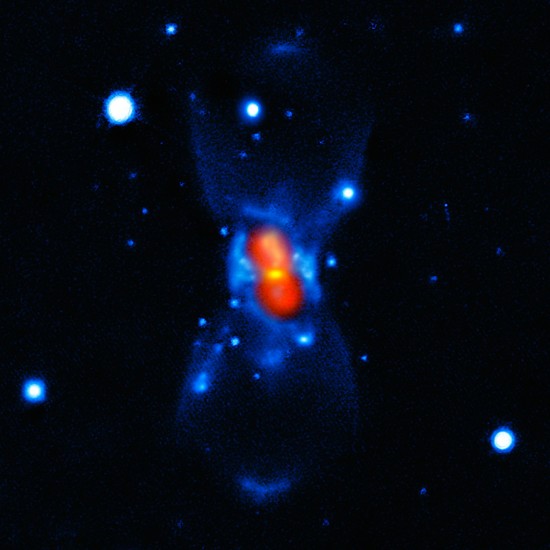
Combined image of Nova Vulpeculae 1670 from the Gemini telescope (blue), a Submillimeter Array map showing the dust (yellow) and a map from the Atacama Pathfinder Experiment telescope (red). Credit: ESO/T. Kamiński
Sep 16, 2015
Electrical activity creates the nova phenomenon.
A nova explosion is thought to take place when a smaller white dwarf star in orbit around a larger companion draws matter onto its surface. Gravity compresses the gas and dust until, at a critical threshold the accreted material reaches fusion temperatures, whereupon it explodes, sending pulses of high-frequency light and powerful shock waves into space.
In the year 1670, the pioneering astronomers Johannes Hevelius and Giovanni Domenico Cassini, noted that a “new star” was visible in the night sky, identified as a “nova sub capite Cygni”: Latin for “a new star below the head of the Swan”. Today, the new star is called Nova Vulpeculae 1670, the oldest recorded nova event.
According to a recent press release, “Nova Vul 1670 did not fit this model well.” As Tomasz Kamiński, a member of the research team wrote: “We have now probed the area with submillimetre and radio wavelengths. We have found that the surroundings of the remnant are bathed in a cool gas rich in molecules, with a very unusual chemical composition.” Why is this composition anomaly so important?
Nova explosions are said to be thermonuclear, so there should be a relatively homogeneous mix. Nuclear explosions are not known to sort materials. So what could be the cause of these anomalies? Is a rewrite of theory required? In the case of Nova Vul 1670, a whole new idea was introduced, the collision of two stars. Why? As the ESO announcement states, “the mass of the cool material was too great to be the product of a nova explosion… and in addition the isotope ratios the team measured around Nova Vul 1670 were different to those expected from a nova.”
Binary pairs of stars are common in the galaxy. More than half of all stars have one or more companions. Since stars are remote from one another, this suggests that something favors the formation of multiple stars. One possible electric mechanism is fissioning. A star’s electrical stress is concentrated on its surface. If the electrical flux is too great, the star might split into two stars. The surface area of two stars is greater than the surface area of one, so the new system is able to accept more electrical stress.
Fissioning to relieve electrical stress presents common characteristics: nova-like brightening and dimming, a change in the star’s spectral type and surface chemical composition, the discovery of a binary companion, and the appearance of a nebular cloud.
The movement of charged particles in plasma generates a magnetic field that constricts the current. As has been pointed out in previous Picture of the Day articles, the constricted channel is known as a Bennett pinch, or z-pinch. Fluctuations form double layers with large potential voltages between them. Electric forces in double layers can be much stronger than gravity, while z-pinches can cause intermittent interruptions in current flow, which would account for Vul 1670’s variability in the past.
As Electric Universe advocate Wal Thornhill wrote: “External electrical or gravitational stresses on a star may cause some of its internal positive charge to be offset from the center of the star. And since like charges repel, the offset charge will tend to accelerate toward the surface. It is a form of internal lightning. This process may lead to the expulsion of a substantial portion of the positively charged interior of the star. The visible result is a nova, or star-wide lightning flash…”
Double layers can accelerate charged particles. Double layers can explode, releasing more energy than is locally present. It is this effect that is seen in stellar flares or so-called “novae.” Instead of revising outdated theories, Electric Universe proponents would like to see a complete revision of thinking where plasma and electric double-layers are given precedence.
Stephen Smith












